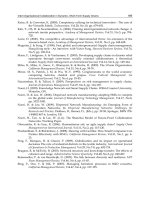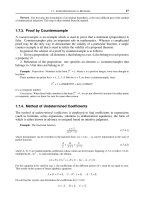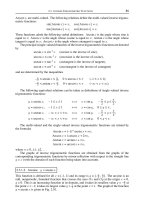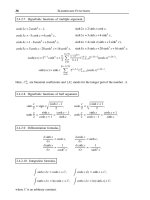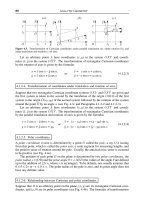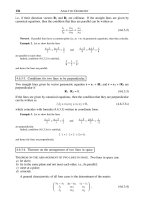Nanomaterials for Nanoscience and Nanotechnology part 10 pps
Bạn đang xem bản rút gọn của tài liệu. Xem và tải ngay bản đầy đủ của tài liệu tại đây (278.44 KB, 12 trang )
butions of their CEND patterns. Before this technique can be effectively and reliably
utilized to extract the sample information coded in CEND patterns of small particles,
many experimental difficulties, such as particle stability, contamination, and accurate
control of beam defocus, have to be overcome.
When metal atoms aggregate from the vapor phase or in a liquid, they usually form
a crystal, having shapes of regular pentagonal bi-prisms or icosahedra (see Chapter 3
for details). Their internal structure is a complex arrangement of five or twenty
twinned components. Large metal particles with shapes of cuboctahedron, decahe-
Scanning Transmission Electron Microscopy of Nanoparticles 109
Figure 4-21. HAADF image of bimetallic particles supported on zeolite crystallites connected by alu-
mina binders and electron nanodiffraction patterns obtained from the six nanoparticles labeled in the
HAADF image. Some of the diffraction spots are clearly split along certain crystallographic orientations
(spot splitting in the diffraction patterns # 3 and # 4).
dron, icosahedron, and other multiple-twinned structures have been observed [74±76].
For particles with sizes smaller than 2 nm in diameter, however, it is difficult to unam-
biguously determine their shape by imaging techniques.
CEND technique can provide information about the shape of clean, metallic nano-
particles. For example, a large portion of clean silver nanoparticles with a size smaller
than 3 nm in diameter was observed to give unique CEND patterns exhibiting almost
five-fold symmetry. These clean silver nanoparticles were formed by in situ deposition
in a UHV STEM instrument (MIDAS). Figure 4-22a shows such a CEND pattern and
Fig. 4-22b shows a simulated CEND pattern of a small icosahedron with the incident
beam direction along the five-fold symmetry axis of the icosahedron. The simulated
CEND pattern closely matches the experimental one. These small particles are not
stable under intense electron beam irradiation. They rapidly change their orientation
and crystal structure [77]. Detailed analyses of CEND patterns recorded on video-
tapes, however, can provide information about the shape of, as well as the defect
structure in, clean nanoparticles.
4.4.2 Coherent electron nanodiffraction with a > y
B
When the incident electron convergent semi-angle a is larger than the Bragg angle,
y
B
, of the diffracting planes, interference effects occur in regions of overlapping discs
(see schematic diagrams of Fig. 4-7). In these overlapping regions, the amplitudes of
waves from different incident beam directions are added. The phase differences among
these waves depend on the values of the transfer function of the probe-forming lens
and the relative phases of the specific reflections of the crystal [8]. The phase differ-
ences vary with the incident beam position relative to the origin of the unit cell of the
crystal. The intensity distribution in overlapping regions becomes sensitive to the probe
position and the microscope parameters, such as beam defocus, spherical aberration
coefficient of the objective lens, and stability of the microscope. Lattice images can be
obtained by placing a STEM detector in the overlapping regions (see Section 4.3.3).
It is possible to determine the detailed atomic arrangement at the core of a defect
by coherent overlapping CBED technique [78, 79]. These CBED patterns can also be
used to determine the local symmetry of a crystal [80]. In principle, analysis of the
110 Liu
Figure 4-22. Experimental (a) and simulated (b) coherent electron nanodiffraction patterns of a silver
nanoparticle with an icosahedral shape. The incident beam was along the five-fold symmetry axis of the
icosahedral particle.
intensity distributions in all overlapping regions of the diffraction pattern should pro-
vide information about the relative phases of all diffracted beams, the basis for unam-
biguous structure analysis of crystals.
A new technique for determining atomic positions using a series of coherent
CBED patterns from overlapping regions has been developed; auto-correlation func-
tions are computed for each probe position, giving atomic coordinates with an accu-
racy of 0.02 nm [5]. However, the most frequent use of these overlapping diffraction
patterns is for the final stages of lens alignment and a stigmatism correction of the
objective lens for high-resolution STEM imaging [81].
When the convergent angle of the incident beam is made even larger, the diffrac-
tion discs overlap at any point of the CEND pattern so that individual discs are no
longer visible. The coherent incident beam may have a central peak smaller than the
projection of the unit cell of a crystal. The CEND pattern depends on the symmetry
and the structure of only that small portion of the projected potential. The intensity
distribution of the whole diffraction pattern changes as the beam is moved across the
unit cell of the crystal. The changes of intensity and symmetry in CEND patterns can
also be observed when an incident beam is scanned across localized defect [79]. By
comparing the intensity variations of CEND patterns across crystal defects to those
simulated by using many-beam dynamical theory, it is possible to deduce the nature of
localized defects in crystalline materials [78, 79].
Recent experiments performed in FE-TEM instruments have demonstrated distor-
tion-free interference fringes in coherent CBED patterns with a lattice spacing < 0.13
nm [82]. The phases of crystal structure factors can be determined from the relative
positions of the interference fringes [83]. This coherent interference technique has
been applied to the investigation of glide planes, stacking faults, and other defects in
crystalline materials [82, 84].
4.4.3 Coherent electron nanodiffraction with a >> y
B
When the convergent semi-angle of the incident beam is much larger than the
Bragg angle of the crystal, the diffraction discs are no longer identifiable, and a point
projection image of the specimen is formed on the diffraction plane. In practice, this
condition corresponds to using a very large objective aperture or no objective aper-
ture at all. In the absence of spherical aberration, this projection image would be a
direct representation of the object transmission function with a resolution determined
by the effective probe size. The magnification of projection images is inversely propor-
tional to the beam defocus [61]. The effect of the spherical aberration of the objective
lens is to introduce distortions in projection images [81, 85]. These distortions become
severe when the in-focus position is approached [85].
For a thin crystal, a special type of projection image, called electron Ronchigram,
can be observed in the diffraction plane (Fig. 4-23) [81, 85]. These patterns are called
electron Ronchigrams because the geometry used to obtain them is identical to that
used in testing optical lenses and mirrors [86]. Electron Ronchigrams can be conveni-
ently used to measure the spherical aberration coefficient and the defocus value of
the objective lens [85]. At large defocus values, projection images are similar to low
magnification TEM images.
Scanning Transmission Electron Microscopy of Nanoparticles 111
A projection image formed by a point source distance Z from an object produces
an identical image to that produced by a plane-wave illumination on a plane at a dis-
tance Z beyond the object. When a thin crystal is oriented along a principle-zone axis,
a slightly defocused projection image can give two-dimensional lattice fringes repre-
sentative of the projected crystal structure.
With the correction of lens aberrations, increased stability of the microscope pa-
rameters, and smaller incident probe sizes, we should be able to study the local struc-
ture of crystals in projection images without using any lenses or scanning systems.
Point projection images formed in STEM are exactly the in-line electron holograms
proposed by Gabor: in-line holograms could be recorded and used to reconstruct the
object wave [87±88]. Gabor suggested that if the reconstruction could be done with an
optical system with appropriate aberrations, the effect of the aberrations on the origi-
nal electron optical images could be corrected and the resolution of the electron mi-
croscope could be enhanced. Initial attempt to reconstruct the object function using
digitally recorded holograms in a computer has shown limited success [89].
For greatly defocused projection images, an off-line electron holography technique
can be effectively utilized to extract quantitative information about the magnetization
in small magnetic particles with a nanometer resolution [90±91].
4.5 Imaging with secondary electrons
High-energy electrons impinging on a solid sample experience elastic scattering by
atomic nuclei and inelastic scattering by sample electrons. Inelastic scattering results
in the transferring of energy from the high-energy electrons to the sample electrons.
Thus, specimen-specific electrons can be excited to high-energy states. Some of the
excited electrons travelling to the sample surface can be emitted out of the sample as
secondary or Auger electrons. By collecting these low-energy electrons, high-res-
olution surface images can be obtained to give morphological information about the
sample (Fig. 4-4). In the following, we will discuss the emission and collection of sec-
ondary electrons, the resolution and contrast of SE images, and the application of the
SE imaging technique to the characterization of nanoparticles.
112 Liu
Figure 4-23. A through-focus series of electron Ronchigrams from under-focus (a) to over-focus (d),
obtained from a thin GaAs crystal.
4.5.1 Emission of secondary electrons
Electron-induced SE emission is a complicated process and is not well understood.
Nevertheless, the emission of secondary electrons from a solid sample can be describ-
ed as a three-step process: generation, transportation, and emission.
The generation of internal secondary electrons is directly related to the electron
energy-loss processes of high-energy incident electrons that undergo a series of inelas-
tic scattering events with an average energy loss of about 20 eV per event. The main
energy-loss peaks are usually associated with the generation of plasmons, the direct
excitation of outer-shell electrons, and the excitation of core electrons [92]. Secondary
electrons can be generated via plasmon-decay or electron-electron scattering pro-
cesses. The relative contribution of each generation process to the total number of
internal secondary electrons depends on the properties of the material under study as
well as the energy of the primary incident electrons. The number of secondary elec-
trons generated inside a solid is often regarded as proportional to the stopping power
(total energy loss per unit path length) of the incident electrons [93±94]. The relative
importance of plasmon-decay processes in the SE production has also been empha-
sized for conducting materials [95±96].
The internal secondary electrons thus generated interact with different components
of the sample such as electrons, phonons, etc. During their diffusion through the solid,
the internal secondary electrons can be scattered both elastically and inelastically.
Elastic scattering modifies their angular distribution while inelastic scattering changes
their energy distribution. The scattering processes of secondary electrons can be best
described by a multiple scattering or diffusion theory of low-energy electrons in solids
[96±99]. This diffusion process of internal secondary electrons is also called the cas-
cade process of SE transportation.
Only a small fraction of the internal secondary electrons may reach the sample sur-
face because of elastic and inelastic scattering processes. Those secondary electrons
that can surmount the energy barrier (work function) at the sample surface can be
emitted out of the sample to become detectable secondary electrons. The final emis-
sion process is sensitive to the surface properties of the sample such as work function,
surface adsorbates, thin layer deposition, sample contamination, surface charging, etc.
The current density of emitted secondary electrons depends on the initial inelastic
scattering events, the decay processes of the initial excitations, the transport of low-
energy electrons through the sample, and the work function and modifications of the
sample surface.
4.5.2 Detection of secondary electrons
In a STEM instrument, a specimen is usually placed inside the pole pieces of a
highly excited objective lens. The emitted secondary electrons first experience a
strong magnetic field before being collected by an SE detector. Due to the effect of
the magnetic field, an emitted SE spirals in a cyclotron orbit with a radius R that
depends on the energy and the emission angle of the SE, and the strength of the mag-
netic field. When secondary electrons travel up or down the optic axis of the micro-
scope, their emission angles are compressed. After spiraling out of the bores of the
objective lens, secondary electrons are collected by an SE detector through a trans-
verse electric field. Because of the effect of the magnetic field on the trajectory of the
Scanning Transmission Electron Microscopy of Nanoparticles 113
emitted secondary electrons, the collection efficiency of secondary electrons in a
STEM instrument is much higher than that in a conventional scanning electron micro-
scope.
The collection efficiency of low-energy electrons can be further enhanced by the
use of electron ªparallelizersº located inside the bores of the objective lens [100±101].
The ªparallelizersº provide a magnetic field that is strong enough to keep low-energy
electrons moving in a small spiral trajectory and traveling out of the bores of the
objective lens. The detection efficiency of low-energy electrons in such systems can be
significantly increased [100].
The energy distribution of the collected secondary electrons can be analyzed by a
low-energy electron spectrometer. Secondary electron spectroscopy (SES) can be used
to investigate the energy distribution of secondary electrons from different materials;
to measure work function of solid samples; and to study the charging effects of non-
conducting materials [102±103]. Localized SES spectra also give information about the
nature of high-resolution SE imaging. High-resolution SES has been used to investi-
gate SE emission processes from metals, semiconductors, and insulators [52, 104±106].
Figure 4-24 shows a SES spectrum obtained from a small MgO cube. Since the
onset energy of the secondary electrons does not shift from the zero value, we can
conclude that there is no observable charge-up of this particular crystal although
MgO is an insulator. Furthermore, the SES spectrum shows that more than 90% of
the emitted secondary electrons have energies < 5 eV. Secondary electrons emitted
from clean, non-charging MgO crystals have a maximum intensity at 1.5 eV with full-
width-at-half-maximum (FWHM) of about 2 eV. Energy-selected SE imaging can be
performed by selecting certain portion(s) of an SES spectrum as an imaging signal to
enhance the contrast of specific features or to improve image resolution and surface
sensitivity.
114 Liu
Figure 4-24. High-energy resolution secondary electron spectrum obtained from a small MgO cubic
crystal shows that more than 90% of the collected secondary electrons have energies less than 5 eV.
4.5.3 Resolution and contrast of secondary electron images
There are two types of secondary electrons emitted at the surface of a sample. Sec-
ondary electrons that are directly generated by the incident beam are termed SE1 and
those that are generated by backscattered electrons are termed SE2. Signals of SE1
and SE2 cannot be distinguished from their energy or angular distributions. Depend-
ing on the incident beam energy and the type of samples under investigation, the total
signal strength of SE2 can be stronger than that of SE1.
The resolution of SE images depends on the rate at which the signal changes as the
probe is scanned across a sample. The contrast of SE images depends on the relative
intensity variations among different probe positions. Therefore, both the resolution
and the contrast of SE images depend on the local current density of the emitted sec-
ondary electrons. With very small probe sizes, the spatial distributions of SE1 and SE2
determine the image contrast and resolution.
In a STEM or a field-emission SEM instrument, the current density of SE1 is much
higher than that of SE2, although the total signal strength of SE2 could be stronger
than that of SE1 for thick or bulk samples. At high magnifications, the SE2 signal var-
ies much more slowly with the movement of the incident probe than that of SE1, thus
SE1 and SE2 signals can be spatially separated. For thin specimens, the contribution
of SE2 is usually negligible. The contrast and the resolution of SE images of thin spe-
cimens are entirely determined by the spatial distribution of SE1 signals.
Sub-nanometer surface details can be observed in high-resolution SE images [107±
111]. This implies that the generation processes of secondary electrons are localized
to within 1 nm or less. It was first pointed out and later experimentally proved that
the generation of secondary electrons is directly related to large-angle inelastic scat-
tering of the high-energy incident electrons [112±113]. There exist large momentum
transfer mechanisms during inelastic interaction processes such as Umklapp or pho-
non-assisted electron excitation processes. Inelastic scattering events involving these
processes are highly localized. The resolution obtainable in SE images is currently
limited by the incident probe size to about 0.5 nm.
The contrast in SE images is primarily due to topographic effect, although other
contrast mechanisms (material contrast, work function contrast, etc.) may play a role
in determining the contrast of SE images of specific samples [93, 112, 114]. Figure
4-25 shows an SE image of a MgO particle revealing surface steps, facets, and the var-
Scanning Transmission Electron Microscopy of Nanoparticles 115
Figure 4-25. High-resolution second-
ary electron image of a large MgO
cube clearly shows flat {001} faces, ter-
raced {011} faces, and the faceted (111)
face. The {011} and {111} surfaces are
composed of {001} terraces or facets.
ious faces of the incomplete MgO cube. Individual atomic steps can be observed in
high-resolution SE images with characteristic black and white contrast for up- and
down-steps, respectively [106]. For normal incidence of the electron beam, all steps
are shown bright but sharper and fainter. The observed contrast of SE images of sur-
face steps can be explained in terms of SE emission from the steps. The amount of
material that generates and emits secondary electrons is greater for down-steps than
for a flat surface and is less for up-steps [106].
4.5.4 Image contrast of small particles
When the radius of a small particle becomes comparable to, or even smaller than,
the escape depths of secondary electrons, most of the secondary electrons, generated
inside the particle, with energies higher than the surface barrier may escape. In con-
trast, because of the effect of total internal reflection of low-energy secondary elec-
trons, only about 10% of the total internal secondary electrons which have energies
higher than the surface barrier can escape from a flat surface. Because of this geo-
metric effect in SE emission, small particles are often observed with a bright contrast
in high-resolution SE images (Fig. 4-26) [109, 112].
The SE signal strength of a small particle increases with the size of the particle.
Furthermore, for metal particles with a radius much smaller than the average escape
depth of the collected secondary electrons, the SE image intensities of these particles
follow exactly those of HAADF images. Figure 4-27 shows SE and HAADF intensity
line-scans, acquired simultaneously, across small, clean silver nanoparticles. These
intensity line-scans clearly show that the SE signal is as localized as the HAADF sig-
nal within the resolution limit which is about 0.6 nm in these images. The SE intensity
profiles almost overlap those of HAADF signal. In fact, the total integrated SE inten-
sity (I
SE
) from a small particle is proportional to the volume of that particle. If we plot
I
SE
1/3
against the particle radius R, a straight line is obtained (see Fig. 4-16), similar to
that of the HAADF signal. Thus, the total integrated SE intensities of small particles
are proportional to the volume of the particles.
116 Liu
Figure 4-26. High-resolution secondary electron images of silver nanoparticles deposited onto clean
surfaces of (a) MgO and (b) a-alumina crystals. Small silver particles are clearly shown with a bright
particle contrast.
The particle contrast in SE images can be parameterized by the ratio of the particle
radius (R) to the average escape-depth (L) of the collected secondary electrons (Fig.
4-28). If R/L < 1, the brightness of a particle increases with the size of the particle and
the image intensity has a maximum at the center of the particle. If R/L > 1, the parti-
cle intensity slowly increases with the size of the particle and the highest image inten-
sity is approximately at a distance d =(R ± L) from the center of the particle. For very
large particles, the particle contrast evolves into the edge-brightness contrast com-
monly observed in SE images.
Although the resolution of SE images is comparable to the size of the incident
probe, it is impossible to extract information about the shape of nanoparticles with
sizes less than the escape depth of the collected secondary electrons. Therefore, we
cannot extract information about detailed surface morphology of very small particles.
However, we can obtain useful information about the relative locations of nanopar-
ticles with respect to the surface topography of supports (Fig. 4-4).
Because of the use of strong probe-forming lenses and field-emission electron
sources, it is possible to obtain SE images with a resolution of about 0.5 nm and 2 nm
at 30 kV and 1 kV, respectively. The collection efficiency of secondary electrons in a
field-emission SEM is also significantly improved due to the utilization of novel SE
detection configurations. It is especially attractive to operate at low electron energies:
the increase in signal strength, the reduced volume of electron-specimen interactions,
and the neutralization of charging effects for non-conducting materials [115±116].
Other advantages of low-voltage SEM include enhanced surface sensitivity at medium
image resolution and reduced radiation damage for delicate samples [115±116]. Metal
nanoparticles, as well as detailed surface morphology of supports, can be clearly
revealed in low-voltage high-resolution SE images with high contrast and high surface
sensitivity (Fig. 4-29).
Scanning Transmission Electron Microscopy of Nanoparticles 117
Figure 4-27. HAADF and SE intensity line-scans across silver nanoparticles. The SE intensity line-scan
closely follows that of the HAADF signal.
118 Liu
Figure 4-28. Schematic diagrams illustrate the emission of secondary electrons from spherical particles
of different sizes and the corresponding SE intensity line-scans across the particles. The parameters R
and L represent the particle radius and the average escape depth of the secondary electrons, respectively.
Figure 4-29. Low voltage, high-resolution secondary electron image of Pt nanoparticles dispersed in a highly
activated carbon. The Pt particles, as well as the nano-pores of the carbon support, are clearly revealed.
4.6 Imaging with Auger electrons
An atomic inner-shell vacancy produced by the incident electrons can be relaxed
through a two-electron process: one electron fills the inner-shell vacancy and the other
is emitted from the atom (Fig. 4-30). The emitted electron is called an Auger electron.
The energies of the primary excitation and of the emitted Auger electrons are both
characteristic of the element(s) involved [117]. The production of Auger electrons is
essentially similar to that of low-energy secondary electrons; the initial excitation pro-
duced by the inelastic scattering of the incident electrons decays to generate a low-
energy electron that can escape into the vacuum. In contrast to the diffusion of sec-
ondary electrons, Auger electrons must escape from the specimen surface without los-
ing any energy in order to be registered as Auger peak signals. The reason that Auger
electron spectroscopy is a surface-sensitive technique lies in the intense inelastic scat-
tering that occurs for electrons in this energy range. Thus, only Auger electrons gen-
erated from the outmost atom layers of a solid can survive to be ejected and measured
in the Auger electron spectrum. Most of the emitted Auger electrons are produced
within a very short distance from the sample surface, typically 0.3 to 3 nm [118].
Scanning Transmission Electron Microscopy of Nanoparticles 119
Figure 4-30. Schematic diagram illustrates the emission of characteristic X-rays and Auger electrons
from a solid sample. The excitation of a core-level electron can be relaxed either by emission of a
photon (characteristic X-ray) or by emission of another electron (Auger electron).
4.6.1 High spatial resolution Auger electron spectroscopy
In a STEM instrument, Auger electrons, emitted from either the entrance or the
exit surface of a specimen, can be collected and analyzed using a CMA (cylindrical
mirror analyzer) or a CHA (concentric hemispherical analyzer) electron spectrom-
eter. Because of the high-energy and high-brightness of the incident electrons, the
employment of magnetic ªparallizersº, and the use of thin specimens in STEM instru-
ments, high-quality Auger electron spectra can be acquired with extremely high peak-
to-background ratios [119±121]. Figure 4-31a shows a high-energy resolution AES
spectrum of clean silver nanoparticles supported on a thin carbon film; the silver
MNN doublet is clearly resolved. The sizes of the silver nanoparticles range from 1 to
5 nm in diameter.
120 Liu
Figure 4-31. Auger electron spectra obtained in a UHV STEM instrument (MIDAS): (a) high-energy
resolution MNN Auger electron spectrum of silver nanoparticles; (b) Auger electron spectrum obtained
from Ag/Pd bemetallic particles.

